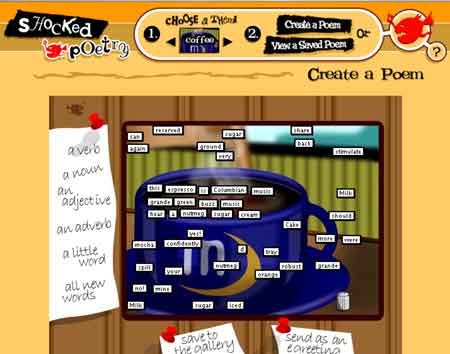|
|
| Vol 15|No 2|December|2005 | |
| Please feel free to e-mail this article to a friend, a principal, a parent, a colleague, a teacher librarian, a college professor, a poet, a magician, a vendor, an artist, a juggler, a student, a news reporter or anyone you think might enjoy it. | |||||||||||||
Inspired Writing
by Jamie McKenzie
|
|
||||||||||||
|
How are American schools and students doing? Consider the results from NAEP: Data from the Executive Summary of the 2002 Writing Assessment:
National writing results have improved little since the arrival of computers and laptops because we have not exploited the special characteristics of electronic text and the features of mindware - programs like Inspiration™ and others that strengthen reasoning and the generation of ideas. We would do much better if we expected less from the equipment and devoted more attention to pedagogy and professional development. The simplest explanation for the disappointing results on the NAEP Writing Assessment is the failure to address the reasoning component of writing with the same zeal with which grammar and style are handled. This gap shows up in the item analysis accompanying the NAEP report. Most American students learn how to string words together in reasonably pleasing patterns but a minority learn to form or share ideas persuasively. On page 18 of the report The Nation’s Report Card - Writing Highlights 2002 (available online for downloading as a PDF file), the nature of a "skillful" response is described as follows:
To score well on these writing tests, students must be quite skilled at the kinds of writing improvements suggested by the Six Traits Approach to Writing pioneered by Ruth Culham. (Her recent book on this approach is 6 +1 Traits of Writing: The Complete Guide.) Students are taught to strengthen their early drafts by making revisions in each of the following categories:
For examples of questions that students might ask while trying to improve their writing by working at these elements, go to http://fnopress.com/start/mod8.html. A persuasive essay must combine good thinking with effective style. The following is a sample of questions from that page designed to improve ideas and content:
Many schools smartly combine this Six Traits Approach with the use of word processing since electronic text supports synthesis and modification. From Idea Processing to Word Processing In this article the focus moves from idea processing - the composition of thoughts - to word processing - the composition of words, sentences and paragraphs in patterns and clusters that are stylistically compelling and full of import. We begin our inquiry with idea processing but shift toward word processing as we figure out what is what. We make up our mind and then start composing (or making up) our sentences and paragraphs.
The Bay Area Writing Project (http://www.bayareawritingproject.org/) and other models of writing as process have portrayed the evolution of a document from pre-writing stages through multiple drafts, revisions and generations.
Much writing takes place away from pen, pencil or laptop as the writer reflects on key ideas while running, strolling or rocking on a front porch. The incubation process is often overlooked during contemporary writing instruction, with the related terms reverie, imagination and invention receiving too little attention. Many schools maintain a cut-and-paste tradition of idea development as if the collection of ideas from sages is the mainstay of research. Students are too rarely challenged to think for themselves and develop their own opinions. They become collectors rather than thinkers. We would hope to see them doing more of the challenging types of thinking shown on the right side of the diagram below, but too often they are stuck with the boxes on the left.
The above diagram is drawn from Chapter One of Learning to Question to Wonder to Learn (McKenzie, 2005). Developing an Independent Point of View Especially when students are conducting research and exploring a demanding question, the pre-writing and incubation stages must be extended. We equip students with mind mapping skills and show them how to weave their findings into tapestries of meaning. They are hunting for clues and evidence that cast light on their questions. Pertinence becomes paramount.
Research engages students in collecting evidence that must be stored where it belongs as the student is doing above with a mind map while learning about Captain Matthew Flinders. Each time she or he encounters an incident that illustrates a character trait, that incident is attached to the pertinent trait and a note is included with the text.
The source of stories and incidents might be a document located at Project Gutenberg's site - a collection of historical documents such as A Voyage to Terra Australis, by Matthew Flinders. http://www.gutenberg.org/dirs/1/2/9/2/12929/12929-h/12929-h.htm Or they may browse through documents at the Flinders Papers at http://www.nmm.ac.uk/flinders/aboutFlinders.cfm.
We have seen too little consideration of the tools themselves and how they might influence writing. Hemingway was rumored to type dialogue but write description longhand. Why? Thomas Wolfe was rumored to write on top of ice boxes and throw pencils over his shoulders when they dulled. Why? Even in this digital age, many report that they write poems with pencil or pen on paper. Why not the laptop? Why the bar napkin? How does the tool shape the product and the production? Electronic text offers many potential advantages, but these advantages are not automatically won by young users. Sitting down at a laptop confers no immediate benefits. Exploiting these benefits depends upon skill and good instruction.
The above visual is based on material first published in Power Learning (McKenzie, 1993, Corwin Press).
A student encounters many thousands of sentences and words while researching a Captain Flinders or Joan of Arc, some of them coming from secondary sources, some of them from official records and diaries. Reading through these texts, the student gathers pertinent stories, quotations and clues, organizing them with a program such as Inspiration™. Each story or clue goes where it belongs, fits into the puzzle where it will. Forty years ago we used index cards. Without explicit instruction on how to manage this collection process, there is danger that the clues and findings will pile up in a hodge podge that does little to provide clarity or insight. The student should be trying to formulate an opinion and substantiate that judgment with evidence. The two go hand in hand - deciding and proving. As evidence accumulates, a judgment forms. Simple collection leads to big piles but little understanding. Mind mapping empowers the student to organize a complex cloud of fragments with much more coherence than was possible with the note cards of old. Mind mapping empowers the student to formulate an opinion and construct a case. But the process is far from linear or logical. In some senses, the student is stumbling toward Insight through trial-and-error, supposition, experimentation, play, guesswork, lurching and regrouping. Coherence Fosters Understanding Organizing our findings makes it easier to draw conclusions. We make lists of pros and cons or line up all the incidents of graciousness against the occasional lapse of judgment or act of arrogance. We weigh the evidence. We try to act and think judiciously. From ancient Greek and Roman civilizations we have seen Justice depicted standing before scales, a blind goddess weighing the evidence fairly. We would hope that our students would learn some standard of judgment that would involve balance and fairness. Is the PC really just a glorified typewriter? Sadly, in some schools students do not make use of computers to write until they reach the final draft. It is simply a way to take a nearly finished product, run it through the spell and grammar checker and print out a clean and snappy looking document. Too few teachers have tasted the power of new writing strategies in a summer writing workshop like the dozens offered each year across the States. The Iowa Writing Project is one example that has reached many teachers (http://www.uni.edu/~english/iwp/index.html). But strong as these programs are in their focus upon effective writing and composition strategies, many of them pay too little attention to the possibilities of new technologies and many pay too little attention to the connection between research, thinking and writing. There are some projects that do address the possibilities of new tools directly such as the Montana Writing Project:
Word Play and Final Versions Composing sentences that are clear but powerful requires an ability to play around with words, testing variations until one combination seems apt.
In contrast, Shocked Poetry provides fewer words to start and allows the poet to add words by part of speech. This sparing approach has its benefits and its weaknesses, but when students can enjoy both of these sites, the contrast between them becomes one of the benefits. The screen shot of the Shocked Poetry site is shown with permission from the site, produced by Moonstone Interactive, Inc. at http://www.msinteractive.com. Given frequent opportunities to play with words in these online environments, students are freed from the constraints and pressures of linear production. Returning to the Six Traits Approach, word choice can become far more spontaneous and enjoyable.
But the online poetry sites take word choice further by giving the student a chance to play with word combinations and patterns. It is not simply a choice of one word over another. The student is stringing a necklace into a pleasing pattern. The Intersection Between Style and Meaning As mentioned earlier in this article, American students have shown little capacity for expressing complex thought as measured by the NAEP Writing Test. Once they have learned to formulate ideas and to take strong positions, they must also learn how to express what they have found in persuasive terms. This expression is a mixture of style and logical exposition, laying out conclusions and findings in patterns that are reasonable but also appealing and full of conviction. The student learns to address a particular audience - how to reach or touch an audience with effective rhetoric. The writing strategies that distinguish between lackluster prose and skillful or excellent responses on the other hand are ones that meld style and meaning together effectively. There have been a number of reports recently decrying the disappointing quality of student writing in the States. Sadly, with the narrow focus of NCLB on reading and math results, writing performance is unlikely to win much attention. Program strategies must be adjusted radically if schools hope to see a return on their technology dollars when it comes to student writing. This article points to a number of changes that could help shift performance, but these changes would all require a substantial investment in professional development. There is no laptop that will win these benefits by itself. There is no packaged program that can be adopted simply. Credits: The photographs in this article were shot by Jamie McKenzie. |
|||||||||||||
 From Now On
From Now On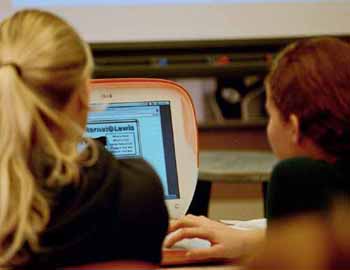


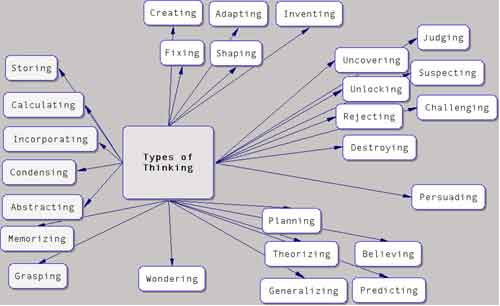

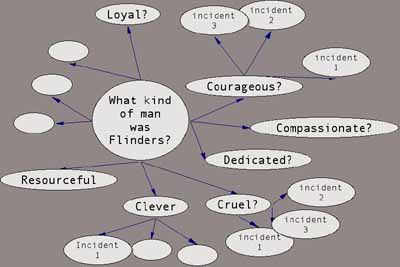




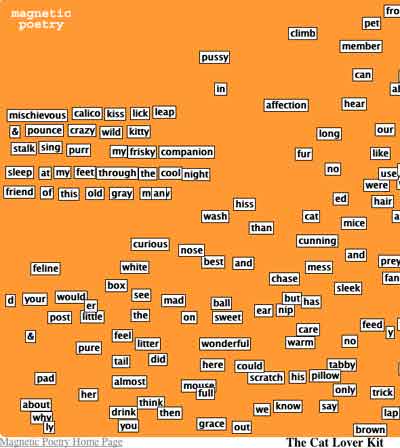 Both of these sites provide word lists devoted to various themes or topics that students may mix, match and weave together in strings and patterns that approximate poetry. Magnetic Poetry provides word lists that are almost overwhelming in their disarray and complexity, but the challenge of dragging a few good words into poetic harmony is akin to the real thing.
Both of these sites provide word lists devoted to various themes or topics that students may mix, match and weave together in strings and patterns that approximate poetry. Magnetic Poetry provides word lists that are almost overwhelming in their disarray and complexity, but the challenge of dragging a few good words into poetic harmony is akin to the real thing.